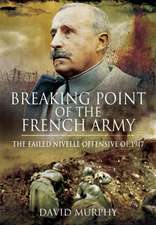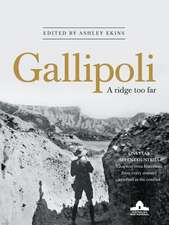For Home and Country: World War I Propaganda on the Home Front: Studies in War, Society, and the Military
Autor Celia M. Kingsburyen Limba Engleză Hardback – 30 iun 2010
World War I prompted the first massive organized propaganda campaign of the twentieth century. Posters, pamphlets, and other media spread fear about the “Hun,” who was often depicted threatening American families in their homes, while additional campaigns encouraged Americans and their allies to support the war effort. With most men actively involved in warfare, women and children became a special focus—and a tool—of social manipulation during the war.
For Home and Country examines the propaganda that targeted noncombatants on the home front in the United States and Europe during World War I. Cookbooks, popular magazines, romance novels, and government food agencies targeted women in their homes, especially their kitchens, pressuring them to change their domestic habits. Children were also taught to fear the enemy and support the war through propaganda in the form of toys, games, and books. And when women and children were not the recipients of propaganda, they were often used in propaganda to target men. By examining a diverse collection of literary texts, songs, posters, and toys, Celia Malone Kingsbury reveals how these pervasive materials were used to fight the war’s cultural battle.
Din seria Studies in War, Society, and the Military
-
 Preț: 163.51 lei
Preț: 163.51 lei -
 Preț: 105.75 lei
Preț: 105.75 lei -
 Preț: 322.37 lei
Preț: 322.37 lei -
 Preț: 206.33 lei
Preț: 206.33 lei -
 Preț: 216.87 lei
Preț: 216.87 lei -
 Preț: 134.21 lei
Preț: 134.21 lei -
 Preț: 136.91 lei
Preț: 136.91 lei -
 Preț: 200.42 lei
Preț: 200.42 lei -
 Preț: 126.80 lei
Preț: 126.80 lei -
 Preț: 189.93 lei
Preț: 189.93 lei -
 Preț: 150.95 lei
Preț: 150.95 lei -
 Preț: 109.10 lei
Preț: 109.10 lei -
 Preț: 164.76 lei
Preț: 164.76 lei -
 Preț: 469.83 lei
Preț: 469.83 lei -
 Preț: 221.77 lei
Preț: 221.77 lei -
 Preț: 214.42 lei
Preț: 214.42 lei -
 Preț: 214.00 lei
Preț: 214.00 lei -
 Preț: 221.16 lei
Preț: 221.16 lei -
 Preț: 469.92 lei
Preț: 469.92 lei -
 Preț: 465.58 lei
Preț: 465.58 lei -
 Preț: 211.16 lei
Preț: 211.16 lei -
 Preț: 227.38 lei
Preț: 227.38 lei -
 Preț: 332.39 lei
Preț: 332.39 lei -
 Preț: 221.38 lei
Preț: 221.38 lei -
 Preț: 220.57 lei
Preț: 220.57 lei -
 Preț: 187.25 lei
Preț: 187.25 lei -
 Preț: 259.16 lei
Preț: 259.16 lei -
 Preț: 184.95 lei
Preț: 184.95 lei -
 Preț: 361.36 lei
Preț: 361.36 lei -
 Preț: 185.13 lei
Preț: 185.13 lei -
 Preț: 328.90 lei
Preț: 328.90 lei - 15%
 Preț: 467.89 lei
Preț: 467.89 lei -
 Preț: 226.18 lei
Preț: 226.18 lei -
 Preț: 185.13 lei
Preț: 185.13 lei -
 Preț: 405.12 lei
Preț: 405.12 lei -
 Preț: 393.58 lei
Preț: 393.58 lei -
 Preț: 147.28 lei
Preț: 147.28 lei -
 Preț: 392.44 lei
Preț: 392.44 lei -
 Preț: 325.05 lei
Preț: 325.05 lei
Preț: 327.17 lei
Nou
Puncte Express: 491
Preț estimativ în valută:
62.61€ • 67.99$ • 52.59£
62.61€ • 67.99$ • 52.59£
Carte tipărită la comandă
Livrare economică 23 aprilie-07 mai
Preluare comenzi: 021 569.72.76
Specificații
ISBN-13: 9780803224742
ISBN-10: 0803224745
Pagini: 326
Ilustrații: 52 illustrations
Dimensiuni: 140 x 216 x 30 mm
Greutate: 0.54 kg
Editura: Nebraska
Colecția University of Nebraska Press
Seria Studies in War, Society, and the Military
Locul publicării:United States
ISBN-10: 0803224745
Pagini: 326
Ilustrații: 52 illustrations
Dimensiuni: 140 x 216 x 30 mm
Greutate: 0.54 kg
Editura: Nebraska
Colecția University of Nebraska Press
Seria Studies in War, Society, and the Military
Locul publicării:United States
Notă biografică
Celia Malone Kingsbury is an associate professor of English at the University of Central Missouri. She is the author of The Peculiar Sanity of War: Hysteria in the Literature of World War I.
Cuprins
List of Illustrations
Acknowledgments
Introduction
1. Food Will Win the War: Domestic Science and the Royal Society
2. "One Hundred Percent": War Service and Women's Fiction
3. VADs and Khaki Girls: The Ultimate Reward for War Service
4. "Learning to Hate the German Beast": Children as War Mongers
5. The Hun Is at the Gate: Protecting the Innocents
Conclusion: Learning to Love Big Brother—or Not
Notes
Bibliography
Index
1. Food Will Win the War: Domestic Science and the Royal Society
2. "One Hundred Percent": War Service and Women's Fiction
3. VADs and Khaki Girls: The Ultimate Reward for War Service
4. "Learning to Hate the German Beast": Children as War Mongers
5. The Hun Is at the Gate: Protecting the Innocents
Conclusion: Learning to Love Big Brother—or Not
Notes
Bibliography
Index
Recenzii
"Kingsbury writes with verve and spirit, extending the theory and impact of propaganda along new avenues of research, with interesting sociological and psychological analyses."—B. Adler, CHOICE
"This is a valuable addition to the fields of twentieth-century history, communications history, and gender studies."—Greg Barnhisel, Journal of American History
"This will be important reading for scholars of World War One in America, and those interested in popular fiction in the early 20th century."—Mark Whalan, American Studies
"We very much need a history of popular literature during World War I, and to understand propaganda in its multiple forms, public and private."—Anthony Seeger, Indiana Magazine of History




